An Unmarked Wagner #12 at 14" and the rest are Griswold's because they are cheap.
For most people, these pans are worthless
On eBay, they’re all super-rare priceless gems!
I enjoy eating, and I have therefore put some work into learning to cook food I want to eat. The Covid lockdown was an almost magical time for me because with no commute to work, I had extra prep time and I cast a wider net for new recipes. I have a modest collection/user pool of Piqua Favorite nos. 3, 5, & 8; one glorious Griswold no. 9; a Smithey (their numbering system is jacked, it would be a no. 10); Field nos. 10 & 12; a Field no. 9 round griddle, Lodge square griddle (sanded and reseasoned), and a Lodge rectangular 2-sided griddle; Griswold Dutch ovens nos. 7 & 8 (the 7 spins like a top but I use it for making bread so it doesn’t matter!); a no-name Target enameled Dutch oven and finally, a Petromax 1.7-qt flat-base camp oven and a Lodge deep no. 12 8-qt camp oven.
I like the Piqua Favorite stuff for its cheerful logo and heat ring. Mine are from eBay but I got them all at low bids so while more expensive that buying Lodge from Walmart, they were already stripped cleaned and seasoned, and smoooooth. I love the little no. 3 because it is light and shallow. Great for a single egg and for toasting nuts. The no. 5 may be the least used piece; the other morning I fried a small amount of bacon in it on a school morning. It’s nice because it fits on the 8” induction element just right. I use the no. 8 predominantly for Dutch babies, cornbread and pillsbury cinnamon rolls. It gives enough space for the rolls to rise without becoming squished together too much.


The Griswold no. 9 skillet is a real beauty. Large logo, heat ring, late 30s production I think? This is what I show people who are dubious about cooking eggs in cast iron. This is the skillet that satisfied me that I’d never buy non-stick ever again. I dislike disposable things, and no matter how much you spend or how careful you are, all non-stick pans are disposable. Bah.
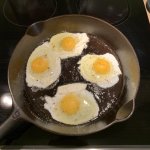
The Smithey is one of the new US “boutique”makers. This skillet is HEAVY. Sort of the antithesis to the classic vintage thin cookware. But it excels at frying, that thick construction and mass help keep the oil temp stable. This pan is so smooth I have trouble holding seasoning. I have inadvertently stripped the seasoning multiple times; I may yet strip it and vinegar-etch it so provide some “key” to promote better seasoning building and retention. But it has a place as the resident oil fryer.
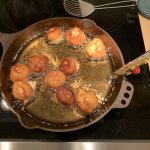

Field is my favorite modern maker. I like their handles the best, they are thin and LIGHT, they have a heat rig, and their finish is both smoothly machined yet retains enough texture to easily take and hold seasoning. They don’t have pour spouts, but I don’t routinely pour gravy I tend to spoon/scoop it, and the flared rim is supposed to act as a pour lip all the way around.



Have you ever had Dutch oven bread? Gosh it couldn’t be easier to make better bread! If you own a Dutch oven, you owe it to yourself to make this happen. Recipes abound on the internets, but basically 3c flour, 1.5c warm water (<130-F), 1tsp salt, 1tsp yeast. Mix dry ingredients and add water. I often. We’d a couple more Tbs more water to get the dough right. Add seasoning to taste like “everything but the bagel” seasoning, rosemary and roasted garlic, whatever. The warm water recipe needs 3 hours to rise, take it out of bowl and plop it onto a floured counter, fold all the edges in all the way around and shape it into a boule, and let it sit 30 minutes while preheating your oven to 450F with the covered DO inside. When heated, I just drop the boule into the hot DO. Most recipes call for you to do that final rise on a sheet of parchment paper so you can pick it up by the paper and transfer it into the oven. I skip that. My breads/oven want about 40 minutes covered, then another 5 or so uncovered to get the exterior browning. You’ll need to experiment with your own oven to achieve the results you want, but don’t let anyone fool you- this couldn’t be easier. There is no mystery, no magic perfect proportions. People act like baking bread is alchemy or witchcraft but this is the easier I’ve ever made bread. Just search for “no knead dutch oven bread” and you’ll find many recipes.
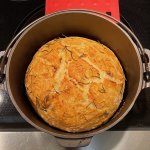
And finally the camp ovens! I’ve only ever used the little Petromax for baking small loaves. Perfect size for big dinner rolls to share at the table, about half the recipe above. But the big oven has been used as intended! I’m looking forward to some weekend dinners in the back yard now that we’ve finally got some cool weather. (**note that the Petromax for all its Germanic design and appearance was made in China. I wouldn’t have bought it if I’d known that, but I could get the lodge 2-qt camp oven at the time so here we are. It’s a nicely made piece, I’m just grumpy about our trade policies wrt China.)

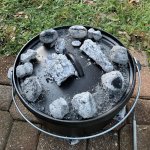

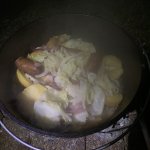
A work on glass top ranges, induction ranges, and heat rings. Glass top “regular” electric ranges are incompatible with heat rings since the system depends on the transfer of heat from the electric element to the pan through direct contact. An induction range works beautifully with a heat ring for a couple reasons. 1. Many vintage pieces are not flat, they can dome up or down in the middle from aggressive heating causing them to wobble and spin. The heat ring helps take the domed middle out of the equation. 2. Induction ranges do not heat through direct contact, rather they creat an electromagnetic field that excites the atoms in the pan (must be made of magnetic material) which produces heat. BE CAREFUL with especially thin vintage CI, you can easily wreck a pan with aggressive heating, and an induction range can definitely do that. I preheat pans about 2 ticks down from medium, then go up to the desired setting. Many recipes that call for finishing in the oven, I will preheat the pan in the oven, cook with that hot pan on the range, then finish in the oven. The secret to cooking with cast iron (well anything really) is heat management. You need to preheat pans before cooking in them, and you need to embrace medium-low to medium heat. Really. I only go over medium once I’ve added food and can hear the sizzle drop so I know to add more heat, or when finishing browning something and cooking off liquid to make the good bits in the pan to create a fond etc.
Go bust out that CI and cook something, and remember why it’s the best cookware available! (Except for boiling water. You do want to KEEP that seasoning, right?!?).


































